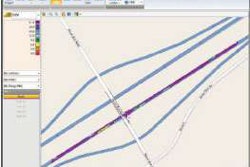All Aboard the(Same) Safety Train

Sound safety practices save lives, prevent injuries and make you a better organization. And having a system that organizes all of a company’s training and safety documents can be a major help in being as safe as you can be . . . and being able to prove it. Software programs designed specifically for this can make a big difference.
Mike Ritter, director of safety at Archbold, Ohio-based Miller Brothers Construction, has been using a safety software system for about four years. It allows him to compile and analyze data to identify safety needs as well as safety program problems.
“Our biggest problem was organizing,” Ritter says. “We compiled our inspection data, but it got shoved in a binder and we didn’t do anything with it.” Now, with the use of safety software, Ritter says he is able to compile data to look for trends, identify training needs and send out safety alerts to share information with crews across the workforce.
Ritter says the company has not received an Occupational Safety and Health Administration (OSHA) citation since it began using the software. Miller Brothers is currently using Safety Application software from HCSS, integrating with Heavy Job software from the same supplier. In tandem, the HCSS programs allow each job to be customized for a company’s specific safety program and needs, which Ritter says has been invaluable to the company’s safety efforts.
The customization enables Miller Brothers to regularly look at the location of at-risk areas and make changes to its safety program as needed to maximize safety and avoid violations and citations. “We can make changes to equipment, to processes, and look at it from a large overview perspective and find out what is going on in the field,” explains Ritter. “We can then improve the whole process, not just a particular step.”
With the Miller Brothers excavation program, a daily inspection is required on all equipment. Before enlisting the use of a software system, there wasn’t any verification that an employee had completed the required inspection or not. “A lot of times this has been written up as an at-risk finding,” Ritter says. This has resulted in OSHA violations with excavation practices. Now, data can be compiled for analysis. “Prior to using software systems for safety, we couldn’t get a feel for how many guys were doing inspections,” Ritter says.
What’s really made a difference with safety was implementation of an inspection checklist that must be completed manually – but is tracked via the software system. Ritter says supervisors can see in real time how many people are doing – or not doing – inspections or other required safety procedures. These data can then be used in performance reviews with superintendents to make them more objective. “It’s more data-driven now; not just subjective,” Ritter says. “The key is customizing inspection checklists to fit specific jobs. There is nothing worse than trying to perform a safety audit, but half of the questions have nothing to do with the job.”
Getting employees involved in the data collection with the software system – and making it easy to use – can make the difference between employees embracing the safety program or viewing it as just another step to do at work. “We did not want to make it overly complicated for them,” Ritter says. “That would just deter them from wanting to use it.”
A culture with no safety police
That’s why company-wide “buy-in” to the program is so important, Ritter says. “Your safety program is only as good as the paper it’s written on – you need to be able to implement the plan,” he says. “Our goal is change the safety culture. We wanted to get away from being considered ‘the safety police.’ We didn’t want the reaction, ‘Oh no, here they come again.’”
This mindset can be eliminated by giving employees a sense of ownership in safety. Customizing segments of a safety program so that employees have to manually check off in an electronic format can be rewarding and not just “Big Brother”-like, Ritter says.
How? “Because there can be a focus not only on things that need to be corrected, but [employees] can be given credit for what they are doing right,” he says. “It gives them a sense of responsibility for themselves and for their co-workers.” It changes the mentality from being just a piece of paper with a checkmark. “It gives them a lot more feeling of ownership as opposed to someone just watching over them,” Ritter says. “They are watching over themselves.”
Ritter says Miller Brothers has avoided OSHA violations during the past four years, because “we have been able to stay on top of any issues we have collected data on and it allows us to stay ahead of any problems. It has certainly changed the way [our employees] look at safety in general. It’s no longer, ‘Here they come,’ but now, ‘Hey, how we help you or you help us today?’”
Keeping it on record
If contractors are out on a jobsite, it’s critical to make sure the correct documents are used, especially when they have been recently updated or safety training is taking place at various locations. “It helps with version control,” explains Steve McGough, chief operating officer for HCSS. “By being electronic, you can make sure everyone has the same document.”
For example: “You can decide as an organization that this Monday you are teaching 6-foot-and-deeper trench safety,” McGough says. “You can push out the documents to the foremen so they have the latest sheets. This way, you know that everyone in our organization is being delivered the same message.”
This can be especially important if, McGough says, “God forbid you have an incident and someone gets hurt. If OSHA comes by, you can show how someone has been trained and when. You have it at your fingertips instead of in a box somewhere.”
RISKY BUSINESS
HCSS COO Steve McGough says there are five safety factors on which contractors often underestimate risk:
1. Work zone safety
a. High-visibility garments on all workers
b. Collisions in the work zone
2. Dangers of backing equipment
3. Excavation and trenching
4. Fall prevention and protection on elevated surfaces
5. Night work











